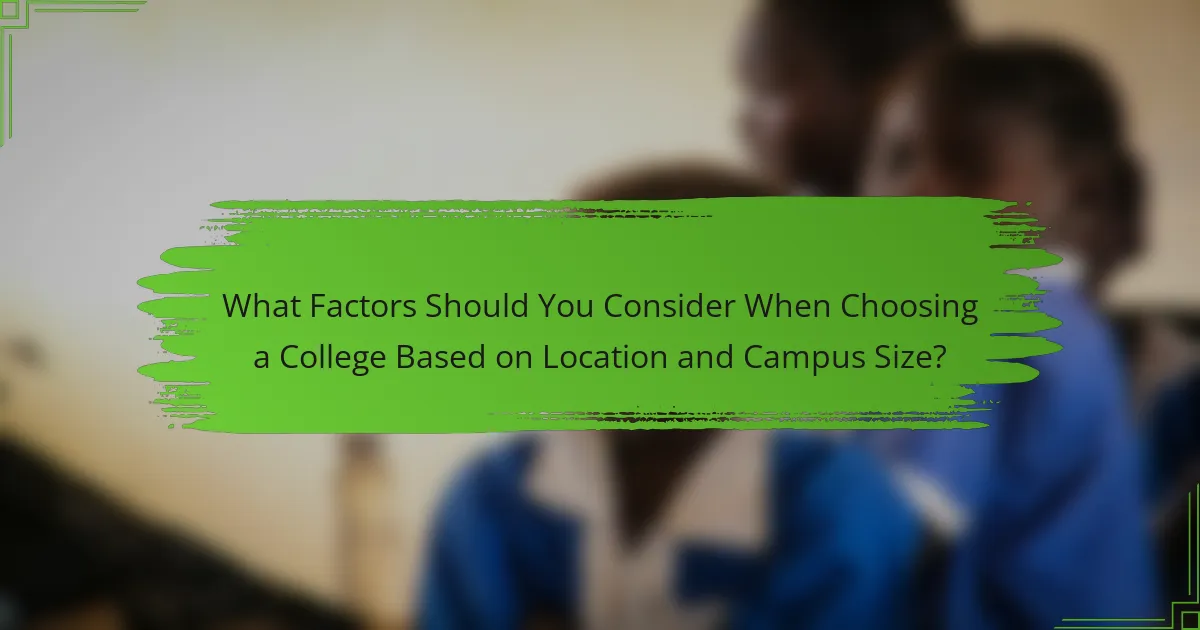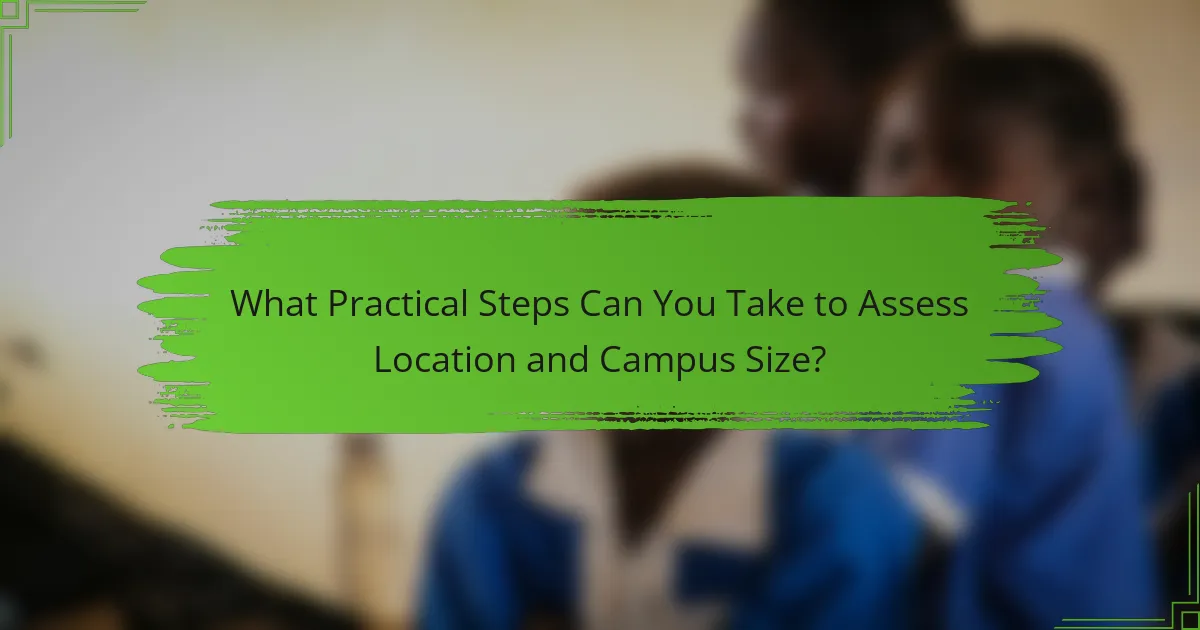
What Factors Should You Consider When Choosing a College Based on Location and Campus Size?
When choosing a college based on location and campus size, consider proximity to home. Being close can reduce travel costs and allow for easier visits. Evaluate the urban versus rural setting. Urban campuses often offer more internships and social activities. Rural campuses may provide a quieter environment and close-knit communities.
Assess the campus size. Larger campuses may offer diverse programs and resources. Smaller campuses often provide more personalized attention and smaller class sizes. Look into the surrounding community. A vibrant local culture can enhance the college experience.
Consider climate and geography. Weather can affect your daily life and activities. Research safety and crime rates in the area. A safe environment is crucial for student well-being.
Lastly, think about transportation options. Access to public transit can ease commuting and exploration. Each of these factors plays a significant role in the overall college experience.
Why is Location Important in College Selection?
Location is important in college selection because it influences students’ overall experience and opportunities. The geographic setting affects access to internships and job prospects. For example, colleges in urban areas often provide more networking opportunities. Additionally, location impacts the cost of living, which can affect students’ finances. A college in a rural area may offer a lower cost of living but fewer social activities. Climate and culture also vary by location, influencing students’ comfort and adaptability. According to a survey by the National Center for Education Statistics, 30% of students consider location a top factor in their college choice. Thus, location plays a critical role in shaping students’ academic and social lives.
How does the geographical location influence college experience?
Geographical location significantly influences college experience by affecting social interactions, academic opportunities, and lifestyle. Students in urban areas often have access to diverse cultural experiences and internships. This can enhance networking and career prospects. In contrast, rural locations may offer a close-knit community and lower living costs. The climate and environment also impact student life. For example, colleges in warmer climates may promote outdoor activities year-round. Conversely, colder regions may limit outdoor options during winter. Local economy influences job availability for students. Areas with thriving industries can provide better part-time job opportunities. Additionally, geographical location affects campus diversity. Urban colleges tend to attract a more varied student body. This diversity can enrich the educational experience through varied perspectives and ideas. Overall, geographical location plays a crucial role in shaping the college experience through social, academic, and economic factors.
What role does proximity to home play in college choice?
Proximity to home significantly influences college choice for many students. It affects their decision-making process regarding financial considerations, emotional support, and commuting convenience. Students often prefer institutions close to home to minimize costs associated with housing and travel. Research shows that around 60% of students attend colleges within 50 miles of their residence. This trend highlights the importance of maintaining familial connections during the transition to college life. Additionally, being near home can provide a safety net for students who may face challenges in adapting to college. Proximity also allows for easier access to home-cooked meals and familiar environments, which can enhance overall well-being.
How Does Campus Size Affect Your College Experience?
Campus size significantly influences your college experience. Larger campuses often provide more resources, such as libraries, research facilities, and extracurricular activities. They may also offer a wider variety of academic programs. This diversity can enhance learning opportunities and networking potential.
Conversely, smaller campuses typically foster a close-knit community. Students may develop stronger relationships with peers and faculty. This environment can lead to personalized attention and support. Research indicates that students at smaller institutions often report higher satisfaction with their college experience.
Additionally, campus size can affect social life. Larger campuses may have more events and organizations, promoting diverse social interactions. Smaller campuses may offer fewer options but can create more meaningful connections. Ultimately, the impact of campus size on college experience varies based on individual preferences and goals.
What are the differences between large and small campuses?
Large campuses typically have more students and a wider range of academic programs. They often feature extensive facilities, including libraries, research centers, and recreational areas. Small campuses usually offer smaller class sizes and more personalized attention from faculty. They often foster a close-knit community among students. According to the National Center for Education Statistics, large universities can enroll over 20,000 students, while small colleges may have fewer than 5,000. Large campuses may provide more extracurricular activities and resources, while small campuses might emphasize a strong sense of belonging and community engagement.
How can campus size impact social interactions and opportunities?
Campus size significantly impacts social interactions and opportunities. Larger campuses often provide more diverse social groups and activities. This diversity can lead to a broader range of friendships and networking opportunities. In contrast, smaller campuses may foster closer-knit communities. Students on smaller campuses often have more frequent interactions with peers and faculty.
Research indicates that students at larger institutions report feeling less connected to their campus community. A study by the National Survey of Student Engagement found that smaller colleges often promote higher levels of student engagement. This engagement can enhance social opportunities and academic collaboration.
Additionally, larger campuses may offer more extracurricular activities and organizations. This variety allows students to explore different interests and meet new people. However, navigating a larger campus can be more challenging, potentially limiting interactions.
Overall, the size of a campus influences the nature and quality of social interactions and available opportunities.
What are the Key Attributes of a College’s Location?
The key attributes of a college’s location include accessibility, safety, community, and amenities. Accessibility refers to the ease of reaching the college via public transport or major roads. Safety encompasses the crime rate in the surrounding area and campus security measures. Community relates to the social environment, including the presence of student organizations and local culture. Amenities involve nearby facilities such as grocery stores, restaurants, and recreational areas. These attributes significantly impact student life and overall college experience.
How do urban, suburban, and rural settings influence college life?
Urban, suburban, and rural settings significantly influence college life through various factors. Urban settings offer diverse cultural experiences and numerous internship opportunities. Students in urban areas often have access to a wide range of services and entertainment options. Suburban settings typically provide a quieter environment with a strong sense of community. Students in suburban colleges may benefit from a balance of academic focus and social activities. Rural settings often offer a close-knit community and a more tranquil atmosphere. Students in rural colleges may experience fewer distractions and a greater connection to nature. Each setting shapes social interactions, academic resources, and personal development opportunities for students.
What amenities and resources are typically available in different locations?
Colleges typically offer a range of amenities and resources that vary by location. Urban colleges often provide easy access to public transportation, cultural institutions, and internship opportunities. Suburban colleges may feature spacious campuses with recreational facilities, parks, and community engagement resources. Rural colleges usually emphasize outdoor activities and may have unique access to natural resources. Libraries, laboratories, and study spaces are common across all types of colleges. Health services, counseling centers, and academic advising are also typically available. The availability of dining options, housing facilities, and student organizations can differ significantly based on the college’s location. Research indicates that these amenities impact student satisfaction and success.

How Can You Evaluate the Campus Size in Relation to Your Needs?
To evaluate campus size in relation to your needs, identify your priorities first. Consider factors like class size, accessibility, and facilities. A larger campus may offer diverse resources and activities. However, it may also lead to larger class sizes, affecting personal attention. Smaller campuses often provide a tight-knit community and more individualized support. Analyze the campus layout and transportation options for ease of movement. Research student-to-faculty ratios for insight into class dynamics. Review campus amenities that align with your interests, such as libraries, sports, or study spaces. Ultimately, match the campus size to your academic and social preferences for a fulfilling college experience.
What Are the Advantages of Attending a Large University?
Attending a large university offers several advantages. One major benefit is the diverse range of academic programs available. Large universities typically provide numerous majors and minors, allowing students to explore various fields. Additionally, these institutions often have extensive resources, including libraries, laboratories, and research facilities.
Large universities also foster a vibrant campus life. Students can engage in numerous extracurricular activities, clubs, and organizations. This leads to enhanced networking opportunities, as large universities attract a wide array of students and professionals.
Moreover, large universities often have access to significant funding. This financial support can lead to better facilities, faculty, and research opportunities. According to the National Center for Education Statistics, large universities tend to offer more scholarships and financial aid options.
Lastly, students at large universities benefit from a broader alumni network. This network can provide valuable connections for internships and job placements after graduation.
How does a larger student body affect networking opportunities?
A larger student body enhances networking opportunities by providing a diverse range of connections. Students can meet peers from various backgrounds, industries, and interests. This diversity fosters collaboration and idea exchange. Larger institutions often host more events, workshops, and networking sessions. These events increase exposure to potential mentors and industry professionals. Additionally, a broader alumni network can offer more job opportunities. Research indicates that students at larger universities report higher satisfaction with networking opportunities. This is due to the increased number of organizations and clubs available for engagement.
What types of resources are more abundant in larger campuses?
Larger campuses typically have more abundant resources such as libraries, laboratories, and recreational facilities. These campuses often feature extensive library collections that support diverse academic programs. They also provide specialized laboratories for various fields, enhancing research opportunities. Additionally, larger campuses usually include multiple recreational facilities, such as gyms and sports fields. These resources contribute to a well-rounded educational experience. Studies indicate that students at larger institutions have access to a wider range of academic and extracurricular resources. This access can lead to improved student engagement and satisfaction.
What Are the Benefits of Choosing a Smaller College?
Choosing a smaller college offers several benefits. Smaller colleges typically provide a more personalized education experience. Students often receive more individual attention from faculty. This can lead to stronger mentorship and guidance. Smaller class sizes foster better student engagement. Research indicates that students in smaller settings often report higher satisfaction rates. Additionally, smaller colleges may offer a tight-knit community. This can enhance networking opportunities and support systems. Many smaller institutions also focus on undergraduate education. This can result in more resources dedicated to teaching rather than research.
How does a smaller campus foster community and support?
A smaller campus fosters community and support through close-knit relationships among students and faculty. This environment encourages personalized interactions. Students often know each other and their professors well. Such familiarity leads to increased collaboration and support networks. Research shows that smaller campuses typically have higher student engagement rates. For instance, a study by the National Survey of Student Engagement found that smaller institutions report greater student-faculty interaction. This interaction enhances academic support and mentorship opportunities. Moreover, smaller campuses often provide more accessible resources and services tailored to individual needs.
What unique programs are often found in smaller institutions?
Smaller institutions often offer unique programs that focus on specialized fields. These programs may include niche areas such as sustainable agriculture, arts management, or community development. Smaller class sizes allow for personalized attention and hands-on experiences.
Programs in smaller institutions often emphasize experiential learning. This can include internships, research opportunities, and community engagement projects. Many smaller colleges also have strong ties to local industries and organizations. This connection can lead to unique partnerships and customized programs tailored to regional needs.
For example, some institutions may offer programs in local history or regional studies. These programs leverage the institution’s location and community context. Additionally, smaller institutions may provide interdisciplinary programs that combine multiple fields of study.
Such programs are designed to meet the interests and career goals of students. They often attract individuals seeking a more tailored educational experience.

What Practical Steps Can You Take to Assess Location and Campus Size?
Visit the college campus to get a firsthand experience of its size and layout. Observe the facilities, housing, and open spaces during your visit. Take note of the campus’s accessibility to local amenities such as shops and public transport. Research the surrounding area to understand the community and its offerings. Utilize online maps to assess the campus’s proximity to urban centers or rural settings. Read student reviews and testimonials about their experiences related to campus size and location. Attend college fairs or information sessions to gather insights from admissions representatives. Compare different colleges based on your findings to make an informed decision.
How Can You Research College Locations Effectively?
To research college locations effectively, start by identifying your priorities. Consider factors such as proximity to home, urban versus rural settings, and climate. Use online resources like college websites and review platforms. Look for campus maps and virtual tours to visualize the area. Check local amenities, including public transport and recreational options. Read student reviews for insights on the surrounding community. Utilize social media groups to ask current students about their experiences. Finally, visit campuses if possible to get a firsthand feel of the location.
What tools and resources are available for evaluating college locations?
College location evaluation tools include college search websites, campus visit guides, and geographic information systems (GIS). College search websites like College Board and Niche provide detailed information about colleges, including location data. Campus visit guides offer insights into the surrounding area and local amenities. GIS tools allow users to visualize demographic data, crime rates, and transportation options near college campuses. Additionally, online forums and social media groups provide first-hand accounts from current students about living conditions. These resources collectively help prospective students assess college locations effectively.
What Tips Should You Follow When Visiting Campuses?
When visiting campuses, prioritize planning and preparation. Research the college’s layout and facilities beforehand. Make a list of questions to ask current students and staff. Schedule tours to gain insights into academic and social life. Observe the campus environment and culture during your visit. Take notes to compare different campuses later. Engage with student organizations to understand involvement opportunities. Lastly, assess the surrounding area for amenities and transportation options.
How can campus tours help in understanding size and location impacts?
Campus tours provide firsthand experience of a college’s size and location. During these tours, prospective students can observe the physical layout of the campus. They can gauge the distance between key facilities such as dormitories, libraries, and classrooms. This helps in assessing the convenience of navigating the campus.
Additionally, tours often highlight the surrounding area. Students can see local amenities, transportation options, and the overall environment. Understanding the neighborhood context is crucial for evaluating lifestyle and safety.
Research indicates that campus visits significantly influence college choice decisions. According to a study by the National Association for College Admission Counseling, 70% of students felt more confident in their choices after visiting a campus. This reinforces the importance of tours in understanding size and location impacts.
What questions should you ask during campus visits regarding size and location?
What questions to ask during campus visits regarding size and location include inquiries about the campus size and its layout. Ask how many students attend the college to understand the population density. Inquire about the student-to-faculty ratio, as it impacts class size and personal attention. Explore the availability of facilities like libraries and recreational areas within the campus. Question the accessibility of public transportation and nearby amenities. Investigate the surrounding environment, including safety and community engagement. Consider asking about the campus culture and how it relates to its size. These questions help gauge if the campus size and location meet your preferences and needs.
The main entity of the article is the selection of a college based on location and campus size. The article outlines critical factors to consider, including proximity to home, urban versus rural settings, campus size, surrounding community, climate, safety, and transportation options. It discusses how these factors influence the overall college experience, highlighting the differences between large and small campuses, their resources, and social opportunities. Additionally, practical steps for evaluating college locations and campus sizes are provided, along with tips for effective campus visits.




